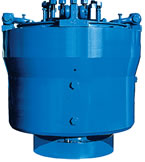And it got me thinking: how does the average Joe or Jane stop offshore drilling, presuming of course that's what he or she wants? It's not as if marching around with picket signs in front of that BP office complex on West Memorial in Houston will have any effect - besides, I drive past it twice a day, and I have yet to see an enraged picketer. Is there a way to stop? It's a tough nut to crack, but the way I see it, there are three ways to stop offshore oil drilling and none of them is likely to happen...
First option: Someone - the Federal government or the states - has to prohibit or severely restrict offshore drilling. California has done this for years, spurred into action by a Unocal blowout off Santa Barbara in 1969. The Federal government has likewise prohibited drilling in the easternmost Gulf of Mexico and in Atlantic Coastal waters for more than twenty years, a policy the Obama administration announced would be relaxed only days before the BP Macondo blowout (see image) on April 20, 2010. The rescission of that policy is, as one might expect, now on hold.
 |
| Photo from the Christian Science Monitor |
Second option: Enact legislation that makes offshore drilling so expensive that it's no longer a profitable enterprise. Increase the cost of drilling permits or require an indemnity bond so massive that no corporate entity can afford it. Realize, of course, that it already costs several hundred million dollars to drill one of these wells...
The political will question arises again for this option, so see the "Elect a government..." answer again. Unless there are two or three more Macondo blowouts in the next decade, rest assured that this will not happen.
Third option: Make drilling for oil unprofitable by reducing the demand. This is easier said than done, for several reasons. One reason is that, although the US still consumes approximately 25% of the world's oil production, the demand in expanding economies, such as China, is on the rise. Already China has surpassed Japan as the world's second largest economy (after the US) and it shows no signs of slowing. Reducing US consumption may no longer have the desired effect of reducing world output.
Currently, the US imports roughly two-thirds of the 20 million barrels of petroleum and finished petroleum products its citizenry consumes every day (in the neighborhood of 12-13 million barrels). In the US, petroleum products are mainly used for transportation. About two-thirds of all domestically-produced and imported crude oil is refined into gasoline, diesel, and jet fuel. The US transportation sector uses approximately forty-five per cent of its total petroleum consumption in the form of gasoline². What does this mean for so-called "energy independence" that offshore drilling will theoretically create? Well, one thing it means is that switching from incandescent bulbs to compact fluorescents does zip for reducing imported oil, because trifling few US power plants run on oil. Much of that imported oil (or oil produced by offshore drilling) goes straight into the fuel tanks of cars, trucks, trains, buses, and airliners.
It's a long way around to this, I know, but if you want to stop offshore drilling without government intervention (which ain't gonna happen as long as there are lobbyists and corporations can buy all the free speech they can afford), then you have to work to reduce the market value of oil. If you want to reduce the market value of oil, you have to reduce demand. If you want to reduce demand, you have to stop using so damned much of it - all those "yous" out there.
¹ per the US Department of Energy records, the two countries from whom the US imports the most oil are Canada and Mexico, neither of which is on any list of "unfriendly" nations.
² per the US Department of Energy again



